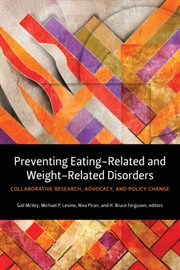Nonfiction
eBook
Details
PUBLISHED
Made available through hoopla
DESCRIPTION
1 online resource
ISBN/ISSN
LANGUAGE
NOTES
This book presents a collection of writings by expert researchers from Canada, the United States, and Australia who are committed to finding common cause and common ground in the prevention of eating disorders and obesity. The ten chapters in this book seek to create a new public health approach to the prevention of weight-related disorders, one that counters the confusion and frustration from public policies, messages, and programs that recipients of prevention efforts often experience. The first section looks at prevention from a public health perspective, and the second section highlights theories from risk and resilience research that can inform the prevention of weight-related disorders. The contributions are varied in their theories and models, but woven throughout is the theme of collaboration in changing public institutions and social systems that promotes universal prevention and fosters mental health and resilience. Unique methods of linking systems and fostering partnerships across sectors and disciplines are highlighted, and readers are exposed to innovative ideas of how to move the field of prevention science forward to reduce the onset of negative body image, unhealthy weight management, eating disorders, and disordered eating. Preventing Eating-Related and Weight-Related Disorders is the second in a series of titles from The Community Health Systems Resource Group at The Hospital for Sick Children. This series will educate researchers, policy-makers, students, practitioners, and interested stakeholders on such topics as early intervention in psychosis, aggressive behaviour problems, eating-related disorders, and marginalized youth in educational contexts
Mode of access: World Wide Web







